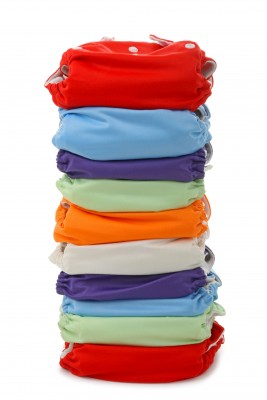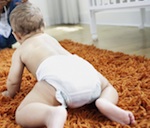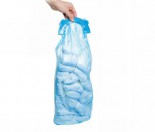Going natural with nappies in NZ reviews your options for natural nappies, natural wipes, wipes and natural washing powders.
When it comes to choosing nappies (and all the related paraphernalia!) there are many factors to consider. Cost, convenience and reliability are usually the biggies, but more and more parents are questioning the effect that ‘nappy time’ has on their baby’s health and on the environment as a whole.
We all know that disposable nappies clog up our landfills, but there is more to nappy time than the nappy itself. Wet wipes, creams and laundry detergent all play a part in your baby’s health and the health of the environment so the decision to go natural involves thinking about the big picture. This article gives you guidelines to natural alternatives at nappy time and outlines the main benefits for choosing to do nappy time naturally.
Nappies naturally
There is no question that disposable nappies have produced a modern-day nightmare for the environment. The Green Party of New Zealand provide information on nappies and their effect on the environment and your baby (see the link below). Not only do they produce 60 times more solid waste than washable nappies, but it takes as much energy to produce one disposable nappy as it does to wash a cloth nappy 200 times. It takes 1.3 million trees a year to produce disposable nappies for NZ babies alone and 1 cup of crude oil per nappy is required to produce the outer plastic. There is no doubt about it, disposable nappies are resource gobblers!
If the convenience of disposables is too much to resist, then using biodegradable nappies is a step in the right direction. Be aware, however, that even ‘biodegradable’ nappies stay put in landfills, because the modern day landfill system lacks the water, air and light needed to break anything down. To really make a difference to the environment, you will need to set up a separate composting system at home for them to biodegrade.
Recycled or chemical-free disposables are also a step forward from conventional disposables, but they still produce an enormous amount of solid waste and use valuable resources in their production. If a disposable nappy brand claims to be eco friendly, you should check out exactly what they are doing to warrant those claims.
Your baby’s health has also been researched in relation to disposable nappy use and some studies have shown links between disposable nappies and asthma in both mother and baby. Most disposable nappies contain chemical gels to absorb moisture and this is also under scrutiny. In 1985 Polyacrylate, (a common ingredient in these gels), was banned in sanitary products because of links to Toxic Shock Syndrome. Strangely it is still allowed in nappies.
With all this to consider, it’s no wonder you are interested in a natural alternative! This article is an overview of your options, but make sure you check out our other Nappies articles to get a full list of pros and cons.
Traditional Cloth Flat Nappies
Traditional cloth nappies are the most affordable of the re-usable options, but they are generally seen as less convenient than other re-usables. If you are using traditional cloths, you’ll also need to purchase over naps, pins, liners and a soaking bucket.
Going Natural with Eco-friendly Cloths
Eco-friendly cloths take traditional cloth nappies one step further. In a general sense, they are the same as traditional cloth nappies, but they are made from eco-friendly fabric such as organic cotton or hemp.
Modern Cloth Nappies
There are several brands and styles of modern cloth nappies, but generally speaking they are form-fitted nappies that snap on in a similar way to disposables. They cost more than traditional nappies, but they are also considerably more convenient. Many suppliers offer sample packs of various systems so you can find one that suits your family.
Traditional cloth nappies and modern day cloth nappies can both be purchased at specialist baby stores, as well as online.
Going Natural with Liners
Going natural with nappy liners is as simple as changing from disposable versions to cloth ones. Many of the modern cloth nappy systems include liners as a part of the package, or are designed in such a way that no liner is necessary.
Natural Baby Wipes
Disposable wet wipes are certainly convenient, but they are not so good for the environment or your baby’s skin. As with disposable nappies, manufacturers claim that wet wipes will eventually break down over several years, but nobody is very quick to say exactly how long that will be. Some wipes are also promoted as hypo-allergenic, chemical-free, or ‘for sensitive skin’, but the reality is they need some sort of preservative to keep them free of bacteria while sitting on supermarket shelves.
If you’re not convinced that wet wipes are good for your baby’s skin, there are other options and if your family is prone to allergies, such as eczema, it is advisable to avoid artificial and scented products. Purchase some soft facecloths or muslins which you can use specifically for baby’s bottom. To make it easy for the whole family, stitch on a coloured tag or choose a specific coloured cloth, so everyone knows these are ‘bottom cloths’ only. Keep the cloths beside the change table, and use a spray bottle to wet them down with water before use. If you want to take a cloth wipe with you when you are out and about, either put a damp cloth in a seal-easy bag or pack your spray bottle as well. Alternatively, use wipes or cotton wool when you are out and about and re-usable cloths in the home.
If your baby is particularly sensitive, you can add a few drops of essential oil to the water to help prevent bacteria and protect their skin. Tea Tree oil is an anti-bacterial and anti-fungal agent, while both Chamomile and Lavender are soothing and good for rashes. To cover all your bases, add a drop of all 3 to your spray bottle.
There are a range of wipe cloths and eco-friendly wipe systems available online, which provide a natural “cleaning” solution in a pre-prepared package. Everything is provided in a user friendly bucket and the cloths are guaranteed to be safe and soft for your baby’s skin. See the sponsored links below.
Going Natural with Barrier Creams
In a perfect world babies’ bottoms wouldn’t need barrier creams, but as parents, we know there are times when nature needs a little help. The first step in preventing nappy rash is to make sure your baby is changed regularly and that they have plenty of time to kick about with their nappies off. Fresh air is the best prevention for nappy rash and babies love the freedom.
If you really need to use a barrier cream, look for one that is good for both baby and the environment. I was always taught that if you wouldn’t put it in your mouth, don’t put it on your skin – and while that may seem a bit extreme, it is a good target to aim for. When choosing a cream for your baby, be sure to consider the following:
Ingredients
The more ingredients in the cream, the more chance there is of your baby reacting to something. Look for creams that have limited ingredients and make sure they are displayed in plain English. Some of the best natural ingredients for nappy rash are Calendula, Chamomile and Tea Tree.
Shelf Life
If the cream has a shelf life of several years, you have to ask yourself what is in it to make it last so long. While it may seem economic to have a long-lasting cream, the effects of the preservatives on your baby’s skin may not be worth it.
While there are some natural preservatives, small quantities of freshly made creams are your best bet. A naturopath or medicinal herbalist will be able to make a mixture which is specific to the needs of your baby.
Packaging naturally
While the packaging has no effect on your baby’s skin, it does have an enormous effect on the environment. Remember: reduce, re-use, and recycle.
Going Natural with Washing Powders and Solutions
When it comes to going natural, this is a biggie. Babies (and older children for that matter) can often react to washing powders or pre-soak solutions and it doesn’t necessarily happen straight away. Residue chemicals can slowly penetrate your child’s skin and the reaction begins to show over time. Because it’s not always an immediate reaction, parents don’t suspect the washing powder unless they have recently changed brands. It’s a hidden evil that is often hard to pinpoint.
By using washing powders or solutions with natural ingredients you not only safeguard your baby, but you make a difference to the environment as well. Here are some tips for washing your nappies, naturally.
- Look for laundry detergents that are advertised as eco-friendly. Generally speaking (although not always!) if an ingredient is good for the earth, it will also be good for us.
- Make sure the laundry detergent is biodegradable. Detergents that are not biodegradable leave residue on the nappy and build up over time. This build-up will also encourage a build-up in your child’s skin.
- Avoid scented detergents; after all, perfume plays no part in getting anything clean, and it’s one more thing that is heading into our waste water. Babies smell delicious all on their own.
- Hang your nappies out in the sun, rather than using a clothes dryer or inside rack. Our grandmothers have always said that sunlight kills the bugs, and now NIWA has the science to prove it. Sunlight also works to keep your traditional cloth nappies nice and white. And the best news of all is that it’s free!
- By all means soak your nappies before washing, but adding a pre-soak solution is not always necessary. If your nappies are wet only (rather than soiled), simply add a few drops of Tea Tree essential oil to the water. Tea Tree works as both an anti-bacterial and anti-fungal agent and is completely safe for using with children.
Useful Articles for Going Natural:
For more information about your nappy options, check out our other Nappies articles in this section.
There’s some great information on Nappy Accessories and Baby Bags too!
For more information on Eczema and how to help your child, see our article in the Allergies section






